Mastering Ornamentation in Classical Sheet Music
Introduction
Ornamentation adds beauty, elegance, and expression to melodies. In the study of classical sheet music, understanding ornamentation is essential for accurate stylistic interpretation. This lesson introduces the four core types: appoggiatura, trill, turn, and mordent—each with its own notation, history, and technique.
Learning to recognize and apply these symbols is a key part of advanced piano online lessons, and many are found in both professional scores and easy sheet music editions, especially when studying Baroque and Classical-era composers.
1. Appoggiatura
This "leaning note" embellishes the main note and comes in two main forms:
(1) Short Appoggiatura
Notated as a small eighth or sixteenth note with/without a slash. It doesn't have theoretical time value but shortens the main or previous note depending on context. It includes:

Single appoggiatura (with slash)

Double appoggiatura (without slash)

Nachschlag, when placed after the main note
(2) Long Appoggiatura
Usually takes half the value of the main note (or two-thirds if dotted). This occurs frequently in classical sheet music, especially in Mozart and Haydn.

In piano notes practice, accurate timing and stylistic understanding are key—particularly in slower movements.

2. Trill
A trill is a rapid alternation between the main note and the note above it. Its notation is a wavy line (tr).

Typically starts on the main note (though can start above)

If preceded by an appoggiatura, the trill starts with it

Accidentals above the trill symbol indicate raised or lowered neighboring notes
Trills are among the most expressive ornaments in classical sheet music, and understanding their use is crucial in piano online lessons.
3. Turn
Turns involve four (sometimes five) notes, ornamenting the main note in a circular motion:

Normal Turn: upper – main – lower – main

Inverted Turn: lower – main – upper – main
Accidentals apply similarly as in trills and mordents
They often appear in Romantic and late Classical scores. They’re frequently simplified in easy sheet music versions, but original editions preserve their expressive potential.
4. Mordent
A mordent is a rapid alternation between the main note and its neighbor:

Upper mordent: main – upper – main

Lower mordent: main – lower – main
Adjusted by accidentals when notated
Though compact, mordents must be executed with rhythmic precision, often featured in Bach’s music and commonly explored in piano online lessons.
Historical Interpretation: Bach and the Baroque
In the Baroque era, ornamentation was highly codified yet varied. Bach’s Notebook for Anna Magdalena included handwritten ornamentation explanations. A trill, for instance, was notated with a wavy line, but it differs in interpretation from later periods.

In Two-Part Invention No. 11, Bach uses multiple ornaments—grey notes in modern editions represent editorial interpretations. Resources like Alfred’s annotated editions are highly recommended for authentic study. Students are advised to avoid editions that replace all ornaments with written-out piano notes, as this removes the opportunity to learn authentic stylistic execution.

Understanding Bach’s approach forms the foundation of interpreting classical sheet music correctly.
Ornamentation in the Classical Era
By Mozart and Beethoven’s time, ornamentation had been streamlined. The four main types became standardized and their execution more straightforward.
Examples:

Mozart Sonata K.545: Simple appoggiaturas and trills

Beethoven’s Tempest Sonata Op.31 No.2 and Les Adieux Op.81a: More dramatic applications
Mozart’s Turkish March (K.331) opens with a long appoggiatura—a good case for rhythmic precision. Rather than notating it as four sixteenths, Mozart uses this ornament for stylistic clarity and phrasing.

In piano online lessons, these nuances are important for developing interpretive skills and are often included in graded repertoire exams.
Romantic & Modern Practice
By Chopin’s time, composers wrote out ornamentation as actual small notes:

Chopin Nocturne Op.62 No.1: straightforward written embellishments

Liszt Hungarian Rhapsody No.2: small notes signal exact rhythm, needing speed and fluidity
Modern composers followed this trend, minimizing traditional ornament symbols.
For those working from easy sheet music, simplified versions often omit dense ornamentation—but advanced players should seek original versions to develop full technical control and stylistic expression.
Conclusion
Learning ornamentation is vital for any student of classical sheet music. It not only improves musicality but also deepens your understanding of historical context. For Baroque works in particular, ornamentation requires care and interpretation—ideally under guidance in your piano online lessons.
On SheetMusicGo, you can find downloadable editions of Bach, Mozart, Beethoven, Chopin, and more—with clear notations for trills, mordents, and appoggiaturas. Whether you’re looking for detailed scores or easy sheet music arrangements to build confidence, our growing library of curated piano notes ensures you’ll always have the tools to ornament with confidence.
FAQs
1. How can I practice ornamentation effectively at home?
Use slow practice with a metronome, then gradually speed up. Follow editorial markings in annotated editions or piano online lessons for guidance.
2. Are ornaments simplified in easy sheet music?
Yes. Most easy sheet music editions either write out ornaments in full or omit them entirely. For deeper understanding, refer to Urtext editions and compare.
3. Can ornamentation be freely interpreted?
It depends on the period. In Baroque works (like those by Bach), performers had more freedom. In later classical sheet music, ornaments are more fixed and should match the composer’s intent—often detailed in piano notes or editorial annotations.












